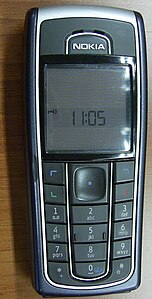Nokia 6230
| Nokia 6230 / Nokia 6230i | |
|---|---|

|
|
| Manufacturer | Nokia |
| publication | 1Q 2004 / 2Q 2005 |
| Technical specifications | |
| display | 128 × 128 pixels / 208 × 208 pixels 16 bit (65,536 displayable colors) |
| Main camera | 0.3 MP (640 × 480 pixels) / 1.3 MP (1280 × 1024 pixels) |
| Current operating system |
Nokia OS , S40 SW version: 05.50 / 03.89 |
| processor | ARM-9 (104 MHz) |
| Internal memory | 8 MB / 32 MB |
| Memory card | 512 MB MMC some firmware also supports larger memory cards |
| SAR value |
0.59 W / kg (Nokia 6230 (Type RH-12)) |
| Connectivity | |
| Cellular networks |
GSM tri-band |
| Further radio connections |
GPRS Class 10 |
| connections |
(USB interface |
| accumulator | |
| Type | Nokia BL-5C Li-Ion 850 mAh |
|
Battery life (according to manufacturer) |
Max. 150-300 hrs |
| measures and weight | |
| Dimensions ( H × W × D ) | 103 mm × 44 mm × 20 mm |
| Weight | 97 g / 99 g |
The Nokia 6230 is a business and multimedia mobile phone from Nokia .
It was launched in mid-2004 and received numerous positive reviews in trade magazines. It had extensive equipment in a classic design and was a best seller. In the second quarter of 2005, the successor, the Nokia 6230i, appeared, which offered some new or improved functions while being almost identical in appearance.
In 2004 demand was greater than Nokia’s delivery capacity. In 2005 the 6230 was the best-selling mobile phone in Europe. According to a study by market research company Telephia , in 2005 more than a quarter (27%) of Europeans who listened to music on a mobile phone used a Nokia 6230.
In December 2005, the successor to the Nokia 6230i, the Nokia 6233 was presented.
technology
Improvements to the 6230i
The Nokia 6230i has the following additional functions compared to its predecessor:
- Push to talk
- Animated 3D menu graphics
- USB interface with USB mass storage support
The display was enlarged by 3 mm and measured 30 × 30 mm. The resolution was increased from 128 × 128 to 208 × 208 pixels.
The resolution of the integrated camera has been increased from 640 × 480 pixels (0.3 megapixels) to 1280 × 1024 pixels (1.3 megapixels). Like most cell phone cameras of that time, the photos of the camera suffered from the small optics and thus from blurring.
The integrated memory has been increased from 8 to 32 MB.
Among the numerous features of the cell phone were also things that were sometimes perceived as annoying. The proprietary e-mail program in particular was criticized as it could send a maximum file size of 100 kB. The new 5-way control pad, which enabled easier navigation through the menu, was praised. The Nokia OS- based operating system S40 ran on the Nokia 6230i .
criticism
The battery life suffered from these many functions . Many customers reported that they had to charge their Nokia device every 1–2 days. With little use, however, the standby time of up to 150-300 hours specified by the manufacturer could be achieved in energy-saving mode.
Due to the higher display resolution, the menu and the camera also responded a little slower (significantly slower for video recordings) than with the predecessor. In addition, it happened with some customers that the mobile phone hung up when using the integrated music player, which could only be remedied by switching the device off and on again.
gallery
Individual evidence
- ↑ European Mobile Consumers Use Music Phones to Listen to Music Four Times more than Americans, according to Telephia. ( Memento of the original from August 18, 2006 in the Internet Archive ) Info: The archive link was inserted automatically and has not yet been checked. Please check the original and archive link according to the instructions and then remove this notice. ( PDF )


